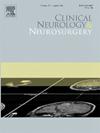预测脑震荡和TBI的住院结果:利用全国再入院数据库的混合效应分析
IF 1.8
4区 医学
Q3 CLINICAL NEUROLOGY
引用次数: 0
摘要
背景与目的创伤性脑损伤(TBI)的特点是严重程度范围广。这种差异对预测预后和制定管理决策提出了挑战,特别是对于遭受较轻损伤的患者。我们提出了一个新的统计模型,用于预测两个倾向匹配队列的医院结果,以优化TBI患者的管理和咨询。方法采用ICD-9和ICD-10编码,从2010 - 2019年全国再入院数据库(NRD)中选择诊断为TBI的住院患者。采用倾向评分匹配基线特征,根据GCS评分将患者分为两组:1188例轻度至中度TBI患者(mTBI, GCS >;8)和1219例重度TBI (sTBI, GCS≤8)患者。采用混合效应建模,采用曲线下面积(Area Under the Curve, AUC)评价模型性能。采用DeLong检验比较各组间ROC模型预测的差异。结果经双变量分析,mTBI患者的平均住院时间(LOS)、住院费用和死亡率明显低于sTBI患者。GCS评分在9 ~ 15分范围内可预测LOS (p <; 0.01),预测非常规出院有显著趋势(p = 0.06)。结论使用先进的混合效应模型,我们的研究发现GCS是TBI诊断后医院预后的准确预测因子。这些结果可能有助于制定预防策略、管理决策和患者咨询,以确保诊断为脑震荡的患者安全恢复日常生活。本文章由计算机程序翻译,如有差异,请以英文原文为准。
Predicting hospital outcomes in concussion and TBI: A mixed-effects analysis utilizing the nationwide readmissions database
Background and Objectives
Traumatic brain injury (TBI) is characterized by a wide range in severity. This variation presents a challenge for predicting outcomes and making management decisions, particularly for patients sustaining less severe injury. We present a novel statistical model for the prediction of hospital outcomes in two propensity-matched cohorts to optimize TBI patient management and counseling.
Methods
Hospitalized patients diagnosed with TBI were selected from the Nationwide Readmissions Database (NRD) from 2010 to 2019 using ICD-9 and ICD-10 codes. Using propensity score matching for baseline characteristics, patients were sorted by GCS score into two cohorts: 1188 patients with mild to moderate TBI (mTBI, GCS > 8) and 1219 patients with severe TBI (sTBI, GCS ≤ 8). Mixed-effects modeling was implemented, and model performance was evaluated using the Area Under the Curve (AUC). Any variance in ROC model prediction between cohorts was compared using DeLong’s test.
Results
After bivariate analysis, the mean length of stay (LOS), hospital cost, and mortality were significantly lower in the mTBI cohort relative to sTBI. GCS scores within the range of 9–15 were predictive of LOS (p < 0.01), with a trend towards significance in the prediction of non-routine discharge (p = 0.06).
Conclusion
Using an advanced mixed-effects model, our study found that GCS is an accurate predictor of hospital outcomes after a TBI diagnosis. These results provide insight that may aid in the development of preventative strategies, management decisions, and patient counseling to ensure a safe return to daily life for patients diagnosed with concussion.
求助全文
通过发布文献求助,成功后即可免费获取论文全文。
去求助
来源期刊

Clinical Neurology and Neurosurgery
医学-临床神经学
CiteScore
3.70
自引率
5.30%
发文量
358
审稿时长
46 days
期刊介绍:
Clinical Neurology and Neurosurgery is devoted to publishing papers and reports on the clinical aspects of neurology and neurosurgery. It is an international forum for papers of high scientific standard that are of interest to Neurologists and Neurosurgeons world-wide.
 求助内容:
求助内容: 应助结果提醒方式:
应助结果提醒方式:


